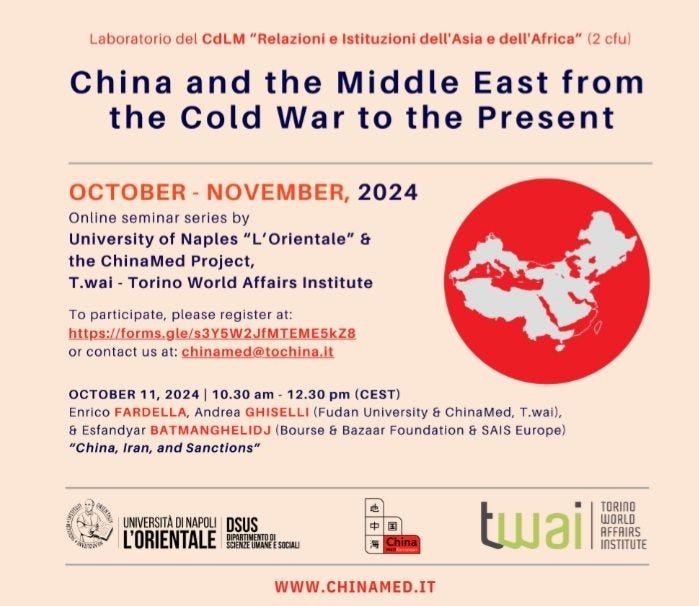PREAMBLE
On October 11, Esfandyar Batmanghelidj (Adjunct Professor at SAIS Europe and the founder and CEO of the Bourse & Bazaar Foundation), together with Professor Enrico Fardella and Professor Andrea Ghiselli, held an online seminar on the often misunderstood relationship between Iran, its sanctioned economy, and China. This was the second session vof the “China and the Middle East from the Cold War to the Present” webinar series for the Fall 2024 semester, organized by ChinaMed Project together with the University of Naples “L’Orientale.”
This a brief summary of the seminar by Esfandyar Batmanghelidj (SAIS Europe and Bourse & Bazaar).
SUMMARY
English-language media and American policy circles frequently depict China-Iran relations as an “axis partnership,” especially since the two countries signed a comprehensive strategic partnership in January 2016, later expanded into the Iran-China 25-year Cooperation Program in March 2021. However, research led by Batmanghelidj on Sino-Iranian economic data reveals that this relationship may not be as robust as commonly portrayed, particularly when compared to China’s flourishing ties with the Arab countries of the Gulf.
Against this background, Batmanghelidj underlined the role of sanctions, raising an important question: is the U.S. sanction regime targeting an already existing “China-Iran Axis,” or is the use of sanctions and other forms of economic coercion in reality contributing to the formation of this so-called axis?
For Batmanghelidj, sanctions undeniably compel Tehran to seek cooperation with Beijing for economic, political, and security-related reasons. On the one hand, Chinese goods help the Iranian market meet fundamental trade needs and supply advanced technology for the military, providing a crucial safeguard in the event of a conflict (should sanctions fail). On the other hand, Tehran’s membership in China-led international platforms such as the Shanghai Cooperation Organization and the BRICS enhances the regime’s legitimacy by demonstrating a degree of international support. However, have Sino-Iranian relations grown stronger due to American sanctions? Not necessarily.
Two Phases of Sino-Iranian Relations through Sanctions
Batmanghelidj examined the depth and strength of this relationship by tracing the evolution of China’s engagement with Iran’s sanctioned economy across two phases: before the signing of the Joint Comprehensive Plan of Action (JCPOA, commonly known as the Iran Nuclear Deal) in 2015; and after the Trump administration's withdrawal from the agreement in 2018.
An often neglected aspect is that the first period of sanctions, from around 2008 to 2012, coincided with the global expansion of Chinese firms into emerging economies, including in the Middle East. During this time, as European companies scaled back their presence in Iran due to sanctions, Chinese goods and investments stepped in to fill the void. However, Chinese firms faced a difficult business environment, including unfavorable legal conditions and the reluctance of Iranian firms to sever ties with their European partners, which limited China’s ability to expand its market presence.
Despite Tehran’s growing dependence on Beijing and the elevation of bilateral relations to a comprehensive strategic partnership in 2016 after the nuclear deal, Sino-Iranian commercial relations did not deepen. With the lifting of sanctions, Iranians swiftly returned to their former European partners, much to the frustration of the Chinese. As such, trade with China declined to levels even lower than those seen before the nuclear deal (as highlighted also by ChinaMed Data) and further plummeted after the Trump administration withdrew from the JCPOA and started its “maximum pressure” campaign.
Source: ChinaMed Data
For China, Iran is “Last Among Equals”
The 25-Year Cooperation Program signed in 2021, in this context, should be viewed as an Iranian attempt to revitalize economic ties with Beijing. However, it has failed to yield desired results. As shown in the previous graph, Chinese imports from Iran remained stagnant and did not improve following the agreement. More critically, a regional analysis of China-Middle East economic relations shows the limits of the so-called “Axis Partnership.” Despite Tehran's heavy reliance on Beijing’s energy market, Iranian oil represented the smallest share of (officially reported) Chinese energy imports from the region. According to ChinaMed Data, over the past five years, Iranian oil exports to China have dropped dramatically—by 96%—from $15,047 billion USD in 2018 to just $561 billion in 2023.
Source: ChinaMed Data
Notably, the United Arab Emirates has emerged as the largest recipient of Chinese investment in the region. Moreover, Iraq, a country that was under US occupation for much of the past two decades, and Saudi Arabia, a crucial US ally, have received similar levels of Chinese investment as Iran, despite Iran's often-perceived close alignment with China.
Ultimately, a comparative analysis reveals that Iran is increasingly being sidelined in the region and that both the 2016 and 2021 versions of the Comprehensive Strategic Partnership failed to foster deeper economic and security cooperation between Beijing and Tehran.
Conclusion
Batmanghelidj’s presentation effectively highlighted the limits of the so-called “China-Iran Axis” narrative. Contrary to common belief, and despite the absence of Western competition, sanctions did not and still do not favor Chinese economic engagement with Iran. Although sanctions may have accelerated Sino-Iranian cooperation, data indicates that this relationship remains significantly weaker than those enjoyed by other regional powers with China. Given the current state of the affairs, it is hard to ascertain whether the Comprehensive Strategic Partnership will enable Tehran to overcome its isolation, especially in the shadow of Beijing’s rising international clout and ambition to reshape global norms.
The ChinaMed Project - T.wai, in collaboration with the University of Naples "L'Orientale", is excited to announce a new series of online seminars on "China and the Middle East from the Cold War to the present" for this Fall 2024.





